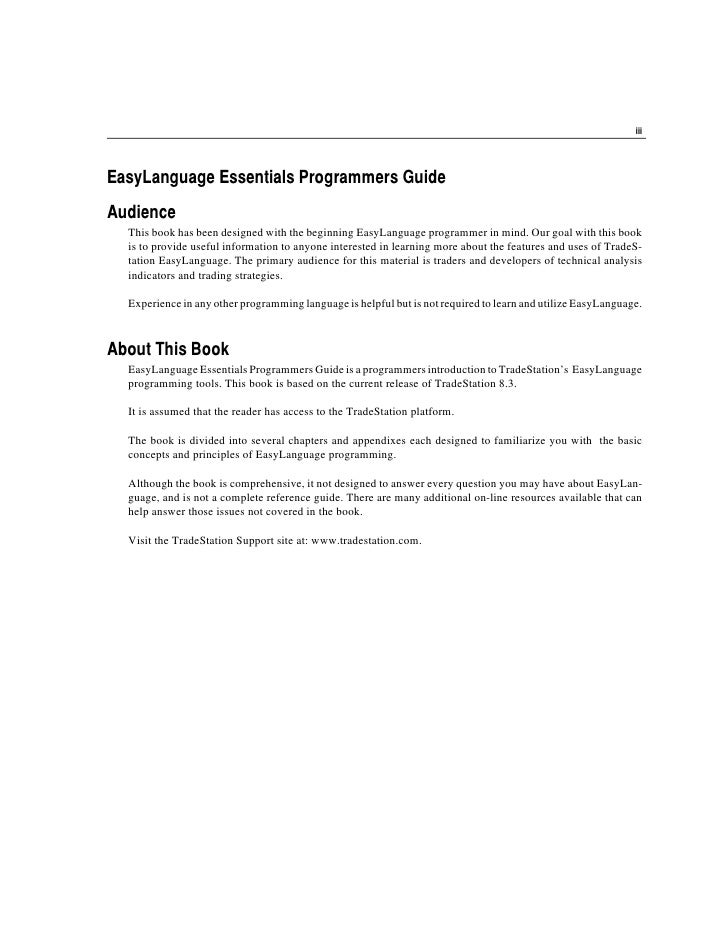

In this Tutorial, you’ll learn how to use the EasyLanguage inputs and variables when programming your Trading System. If you want to assign a default value to your program, for example, a Moving Average Lenght, you have to insert the inputs in your code.
The inputs are in the first part of the code. You can choose any name for your inputs, for example, MA_Lenght or Moving_Average_Period. Remember that you can’t use the space.
Graphical inputs are essential: color, width, etc. We hope this EasyLanguage tutorial was useful for you. You can use this information to create indicators or trading systems with TradeStation and MultiCharts. Do you want to learn EasyLanguage & PowerLanguage for TradeStation and MultiCharts? Start here: EasyLanguage & PowerLanguage Master Tutorial.
Besides, you can’t even use reserved words.
- Oct 27, 2019 EasyLanguage is an easy-to-learn, but powerful, computer programming language for creating technical in-dicators and trading strategies for the TradeStation trading platform. EasyLanguage is designed by traders, for traders, to de scribe trading ideas to a co mputer in plain English-like.
- The Easy2C® translators contain a syntax analyzer, a EasyLanguage to tertiary converter, and a tertiary to C# converter. The syntax analyzer scans the EasyLanguage input file for syntactic errors and generates a listing file of the EasyLanguage program. Any syntactic errors will be flagged with detailed English messages in the listing file.
- Hi I am converting some EasyLanguage code and wanted to confirm the operation of the function IntPortion, does it always round down, i.e. Is IntPortion(4.56) 4 rather than 5? The reference guide I have found so far on the web only gave an example where rounding could not have applied:eek.
- EasyLanguageProgrammer.org is trying to bridge the gap between traders seeking help with custom programming and the programmers. This does not only go for Multicharts or Tradestation, but for Ninjatrader, Metatrader, eSignal and every other trading platform.
You can find all the reserved words HERE.
PowerLanguage for MultiCharts has some reserved words that are different.
Finally, you can’t use any characters like ( % & / ). If you use these characters, The Build Tab will show you an error message.
You can use the word “Input” or “Inputs” with two points and the default value in brackets.
In PowerLanguage with MultiCharts is the same. You can enter all the inputs you want. The last input must be followed by a semicolon.
In this EasyLanguage Tutorial now we’ll discover how many types of inputs exist.


There are many types of Input:
- Numeric
- Boolean
- String
- Color
EasyLanguage Inputs – Numeric
It’s simple… It’s a number value. In the bracket, you can insert one number or one formula.
It’s correct a number with a decimal, separated with a dot.
EasyLanguage Inputs –Boolean
Easylanguage Essentials Login
The Boolean input contains a true/false input. For example, you can use it to activate or deactivate a condition.
EasyLanguage Inputs – String
Easylanguage Essentials Pdf
In the string input, you can write a text in the middle of the quotes.

EasyLanguage Inputs –Color
In the color input, you can insert color, the color in EasyLanguage are reserved words:
Final Consideration
When you attach your custom indicator to the chart, you’ll change your inputs. Generally, a trading system with a high number of inputs is considered more user-friendly. Graphical inputs are essential: color, width, etc.
We hope this EasyLanguage tutorial was useful for you. You can use this information to create indicators or trading systems with TradeStation and MultiCharts.